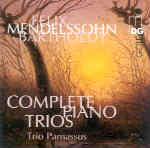For technical aplomb and ensemble precision Trio Parnassus maintains similar high standards in Mendelssohn’s two trios as it did in its earlier Schumann cycle for MDG. Yet key musical elements are lacking. The musicians don’t allow much in the way of varied textures and articulation, and they generally treat melodic and accompanying material on the same level. Perhaps the resonant engineering contributes as well. Take the D minor trio’s finale, for instance. There’s a sequence where the piano carries the main theme while the violin and cello toss pizzicato lines back and forth in sneaky accord. The Parnassus players merely deliver the notes, while the Abegg Trio on Tacet shapes this passage to more dramatic, three-dimensional effect.
Similarly, the Abeggs handle the surging string crescendos in the C minor trio’s opening movement with greater purpose and specificity compared to the more generalized, foursquare delivery that persists throughout the present recording. Pianist Chia Chou also likes to taper phrase endings in the solo statements that begin both works’ slow movements, whereas the Abegg’s Gerrit Zitterbart keeps them moving without compromising the music’s lyric sentiment. The D minor trio boasts numerous excellent recordings, such as the Suk Trio (Supraphon) and the electrifying Martha Argerich’s EMI traversal with Renaud and Gautier Capuçon. For both trios, I heartily recommend the Vienna Piano Trio (Nimbus) and Trio Fontenay (Teldec), while the aforementioned Abeggs also include the D minor trio composed by Mendelssohn’s sister Fanny.
































